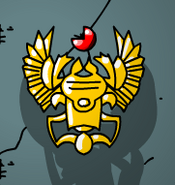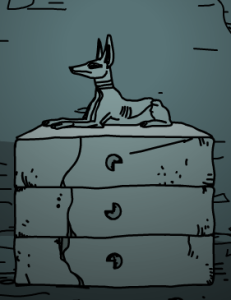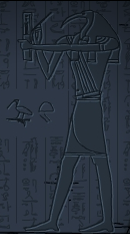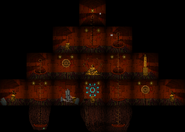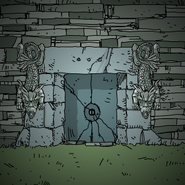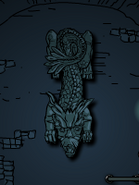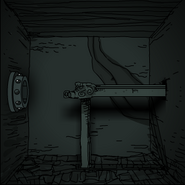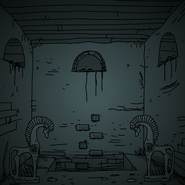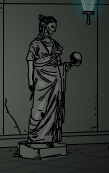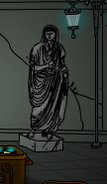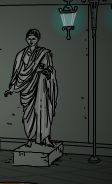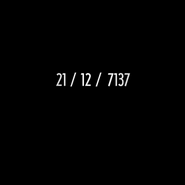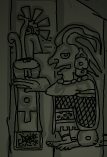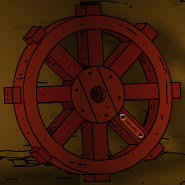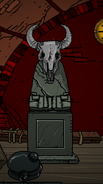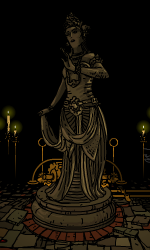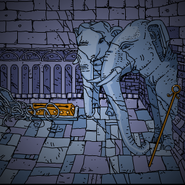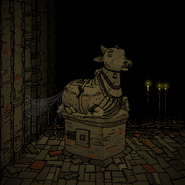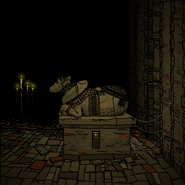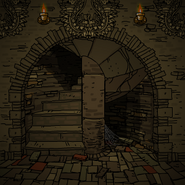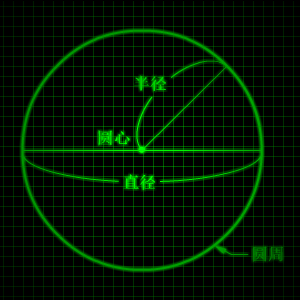It has been observed that there is a large span of influence on the Submachine series that originates from ancient civilizations and cultures. Many theories of the Submachine state that the Submachine itself can travel through time, offering an explanation for relics and temples discovered. Other theories state that the Submachine seems to be able to "absorb" things into itself; old abandoned temples and such could be absorbed merely by location. Yet a third viewpoint states that the people who built the Submachine used ancient "magic" to help in the building of the Submachine (like the Chronon in the Edge). However, the true explanation may be a combination of the three, or may even be something totally different.
Visit the gods and deities in the Subnet page for more extensive descriptions and in-game pictures of gods and deities represented in the games.
Visit the runes page for more information on the wide usage of runes and symbols in the Submachine series.
Egypt[]
Scarab[]
In Submachine: Ancient Adventure, the inside of the ancient ruins has carvings of beetles in certain rooms. Some have gold overlaying them. The beetle returns as a stone relief and a collectible item made of brass in Submachine 9: The Temple.
These beetles are called scarabs, amulets that represent the cycle of the sun through the sky during a day, and as such they were related to Ra.[1] They were often used as seals, carrying the names of important people. Some pharaohs even published commemorative scarabs to praise themselves.[2]
External reading: Scarab
Anubis[]
A statue of a jackal representing Anubis blocks the entrance to the chamber containing the Wisdom Gem in the ancient ruins. Similar statues are located in the ancient section and in the Root. Anubis also makes an appearance in Submachine 10: The Exit as a pair of rotating jackal head statues in the iron pyramid. When activated, the statues teleport the player to different parts of the location.
Anubis was the divine embalmer and one of the mighty gods of the underworld.
External reading: Anubis
Thoth[]
In Submachine 6: The Edge, in the tunnels area, there is a portrait of the Egyptian god Thoth. This engraving can also be found in a secret location in the cliffs. There, information can be read about Thoth. In the chronon area Thoth's name is on the hour glass wheel, written with hieroglyphs. The chronon's walls themselves are covered in hieroglyphs. Closer inspection reveals that they display the same sentences over and over again. Thoth is again mentioned in a note in Submachine 10.
Thoth was the Egyptian god of magic, writing, science and also helped with judging the dead. Thoth, in ancient Egypt, was worshipped mainly in the city of Hermopolis. He is usually shown with the head of an ibis and the body of a man.
External reading: Thoth
Pyramids[]
The pyramid from Submachine 9, the pyramidion from the Submachine Universe, and the iron pyramid from Submachine 10 are all locations that are triangle-shaped, possibly referencing the pyramids of Giza.
External reading: Giza pyramid complex
Eye of Horus[]
An eye of Horus can be found in Submachine 9 and Submachine 10. It appears on a brass plate, twice in the pyramid and twice in the iron pyramid. In both instances it is used to signal to the player where a device in one room can solve a problem giving access to another part of the location in a second room.
The Eye of Horus is an ancient Egyptian symbol of protection, royal power and good health.
External reading: Eye of Horus
Arab culture[]
The resin temple, while having Greek Ionic columns, also bears a calligraphic phrase written in Arabic on the bases of the columns.
External reading: Islamic calligraphy
Babylonia[]
The circle god in the pi room is built with a design similar to Babylonian statues. It is unknown which god this statue represents.
External reading: Lamassu
Caananite religion[]
In Submachine 4, the statue (thought to depict Murtaugh in-game) is a replica of an ancient deity commonly referred to as El or 'El. The name referred to either any general deity in the Canaanite religion or to a specific god of creation and supreme deity over all others.
External reading: El (deity)
China[]
In Submachine 0, there are two sculptures of dragons that flank the door leading into the ancient ruins. This dragon also appears in the Submachine Universe in the excavation site.
In Submachine 6: The Edge, inside the tunnels, there is a stone lever with a dragon head in its end.
Asian dragons were usually serpentine, wingless, and had clawed feet. They were usually associated with water and rain.
External reading: Chinese dragon
Mesopotamia[]
A ziggurat makes up a location in the Submachine Universe. A ziggurat is a Mesopotamian temple tower, resembling a pyramid.
Ziggurats were seen as resting places of gods by many, and as such they were not for common folk. Only priest could climb to these temples and attend to their duties.
It seems that there were shrines on top of the ziggurats. This is nicely represented by placing the portal on the top of the building.
The material of the ziggurat is not common Mesopotamian, however, but rather in the style of the Mainframe of the Edge. Even the footsteps in the side of the tower are the same as the ones found there, which are theorized to have been built for Sub-bots.
External reading: Ziggurat
Etruscan[]
Statues of Etruscan horses appear in Submachine: Ancient Adventure, Submachine 4: The Lab, and the Submachine Universe. They border the doorway to the ancient ruins, guard a secret in the ancient section, and adorn the long hallway that makes up the pony room. In the pony room they also take the form of a pegasus and a unicorn.
Horses were symbols of strength in the Etruscan civilization, and small metal figures were often placed in tombs and temples.
External reading: Etruscan civilization, Pegasus, unicorn
Germanic[]
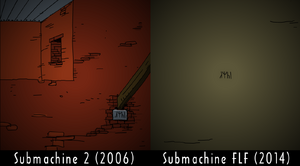
The rune pattern from Submachines 2 and FLF.
Main article: Runes
In the Submachine many instances of runes can be found. The most well-known rune pattern of the Subnet is the set of four runes seen in Submachine: Future Loop Foundation, Submachine: FLF, Submachine 2: The Lighthouse, and again in Submachine 10: The Exit. It uses two runes from younger Futhark - ᛘ and ᛁ - but doesn't use two of the other runes. In the Dalecarlian runes from 1706, this word would translate as emni[3], but there is no indication this is the right transliteration.
Many other types of runes are used in many other parts of the Subnet, such as the defense system and even in the Core.
Originally runes were used by different Germanic tribes. Runes were developed by them from the Old Italic Alphabet[4] as their own writing system. Other peoples took these runes and made their own versions of them afterwards.
Traditionally runes were often used in various rituals.
External reading: Armanen runes
Greece/Rome[]
Doric columns[]
The sanctuary of Submachine 7: The Core and Submachine Universe strongly resembles a classical temple, in that it has and smaller structures often found in such temples. In Submachine 7: the Core, the sanctuary and part of the columns have been destroyed.
External reading: wikipedia:Doric order\Doric order
Roman leaders[]
Four statues appear in the Winter Palace in Submachine 7.
The statues represent the following figures.
- Urania - Muse of astronomy.
- Augustus - A caesar of Rome.
- Eumachia - A priestess of Venus, and more importantly the matron of a cult that worshipped Augustus. Alternatively Augustus as Pontifex Maximus, the Roman high priest.
- Tiberius - Yet another caesar of Rome, who ruled when Eumachia was alive.
In Submachine 8, there is also a reference to the legend of Alexander the Great and the Gordian Knot found in a note. [5]. Alexander the Great was a king of Macedon, in northern Greece.
External reading: Urania, Augustus, Eumachia, Pontifex Maximus, Tiberius, Alexander the Great
North America: Rock paintings[]
The rock paintings found within the bamboo town in Submachine 8: The Plan resemble paintings made by North American tribes and resemble a cowboy, a deer and a man with spear. The whole background of the area resembles the Foggy Mountains, a state park found in USA.
External reading: petroglyph
Central America: Aztec[]
The calendar seen in the end of Submachine: 32 Chambers is an Aztec calendar stone. It is an exact replica of the Stone of Sun (Spanish; Piedra del Sol) or Cuauhxicalli (Eagle Bowl).
It was excavated in the Zócalo, Mexico City's main square, on December 17, 1790[6]. It represents the months used by the Aztecs that were identical in system to the Maya calendar but named differently. It was during the reign of the 6th Aztec monarch in 1479 that this stone was carved and dedicated to the principal Aztec deity: the sun. The stone has both mythological and astronomical significance. It weighs almost 25 tons, has a diameter of just under 12 feet, and a thickness of 3 feet.[7]
The face in the middle is the Aztec sun god/Lord of Heaven, Tonatiuh. Although this is a little obscure in the game, the deity's tongue is hanging out. This represents his desire to drink the blood from human sacrifices.
The four slots to which the bacab plates are attached represent the four Olin, the previous epochs, also known as Suns. The out-most ring in turn represents the twenty named days.
External reading: Aztec calendar stone
Central America: Maya[]
Calendar[]

This wall of glyphs seems to talk about dates.
The dates involved in the game's ending sequence - 21st of December 2012 and 21th of December 7137 - are a reference to the Maya long count calendar.
The Maya believed that life could be divided into certain cyclical periods of time, which were represented on this calendar.
External reading: Tzolk'in, Mesoamerican Long Count calendar
Gods and deities[]
Find more information on these gods and deities on the gods and deities in the Subnet page.
The Bacabs are also seen in the form of four collectible plates. They are are a group of four gods, children of Itzamnaj and Ixchel. (Chak Chel is believed to be a personification of Ixchel). The Bacabs held up the world on their shoulders, similar to the Greek god Atlas.
Hieroglyphs[]
Submachine: 32 Chambers contains many Maya glyphs that take on different meanings.
Many of the glyphs in the game appear to be taken from Maya calendar and codices, and given a new meaning. For example, the symbol ![]() looks almost exactly the same as the symbol
looks almost exactly the same as the symbol ![]() , which refers to a day in the Tzolk'in calendar, kib. Similar cases are
, which refers to a day in the Tzolk'in calendar, kib. Similar cases are ![]() ,
, ![]() and
and ![]() which are similar to the glyphs
which are similar to the glyphs ![]() ,
, ![]() and
and ![]() respectively, and all correspond to a Tzolk'in day. All of the mentioned symbols follow the simplified style of writing the names of the days using in various codices.
respectively, and all correspond to a Tzolk'in day. All of the mentioned symbols follow the simplified style of writing the names of the days using in various codices.
Maya hieroglyphs were the method of writing in the ancient Maya society. It seems that the hieroglyphs were used especially to write the Ch'olti' language, which appears to have been the Maya lingua franca. When other Mayan languages were written, these glyphs were generally used. Nowadays we can decipher almost all of the Mayan language, with some accuracy.
Glyphs are read from left to right and top to bottom; however, they were usually organized into columns of two glyphs.
In the menu, the glyphs seen can all be located in the Wikipedia picture of Palenque glyphs.
List of named hieroglyphs[]
Keep in mind that many of these glyphs are not named to reflect what they mean in the real world.
| Glyph | Given meaning |
|---|---|
| Ah Puch | |
| Air | |
| Air | |
| Box | |
| Chak Chel | |
| Drink | |
| Fire | |
| Greeting | |
| Ixtab | |
| Mole | |
| Refutation, denial, rejection | |
| Sand | |
| Tooth | |

|
Wind |
| Water |
External reading: Maya script, famsi.org, mesoweb.org for identifying Maya hieroglyphs
Reliefs[]
In the Submachine: 32 Chambers, one can find a relief of a human, seemingly steering a rocket ship. This type of relief has caused multiple conspiracy theories across the globe. They have even been seen as proof of interstellar travel of other intelligent species to Earth. Furthermore, it is speculated from this picture that the Maya had the technology to fly.
In 1952 Ruz Lhuillier was excavating the staircase of the Pyramid Temple when he found a sealed passageway that led to the burial crypt and sarcophagus of King K'inich Janaab' Pakal of Palenque. This was the first burial crypt found in Central America, let alone in a pyramid, and fueled a debate that the Mayas were in some way connected to Egypt. The lid of the sarcophagus is the depiction of King K'inich Janaab' Pakal .
The lid has been theorized to actually depict K'inich Janaab' Pakal falling through the Milky Way into the Underworld, Xibalba. The face behind him is the water god who guards Xibalba.
External reading: K'inich Janaab' Pakal
Stelae[]
In Submachine: 32 Chambers, there is a replica of the Stela N of Copán, Honduras.
Stelae are commemorative stone or wood statues, taller than they are wide. They usually have the name of the event or the deceaced if the occasion is a funeral. The stone slab also has a relief carved to it.
The Stela N was built to honour the fifteenth king of Copán, K'ak' Yipyaj Chan K'awiil, which roughly translates to Smoked Shell or Smoked Squirrel.
K'ak' Yipyaj Chan K'awiil ruled some years after Copán had a major setback; its thirteenth king, Uaxaclajuun Ub'aah K'awiil, was captured and killed by the rebelling vassal nation, Quiriguá. K'ak' Yipyaj Chan K'awiil and his son did a lot of work regaining the power Copán.
External reading: Stela, Copán
Central America: Olmec[]
Submachine: 32 Chambers features an appearance of a piece of Olmec culture. In one of the 32 chambers you can find an Olmec colossal head, which is the most widely recognized Olmec object.
The colossal heads are from 1.47 meters to 3.4 meters high, and have been estimated to weigh up to 50 tons. It is speculated that these heads depict some sort of chieftains, dressed like players of Mesoamerican ballgames. No two heads that have been found are the same. They are made from volcanic basalt, found in the Tuxtlas mountains (or Sierra de los Tuxtlas).
External reading: Olmec, Tuxtlas mountains
Central America: Toltecs[]

Chac Mool statue
Chac Mools which literally means Thundering Paw is the given name to a type of Toltec statue. They were made by Toltecs and other American Indians in areas with heavy Toltec influence. Toltecs were held high by the Aztecs as their cultural predecessors, in a similar manner as Europe holds Rome and Greece as its predecessors.
The true name for these statues remain unknowns to this day. The Chac Mool depicts a human figure in a position of reclining with the head up and turned to one side, holding a tray over the stomach. The meaning of the position or the statue itself remains unknown.
These statues were often found in temples.
In Submachine 32 the Chac Mool holds a goblet that is initially empty. The hieroglyphs imply that the statue refuses to drink water. This is a subtle clue hinting that it will instead drink sand.
External reading: Toltec, Chac Mool
South America: Nazca[]
The Nazca room from Submachine Universe is dedicated to the geoglyphs of Nazca. These huge formations, better known as the Nazca lines, were created by scraping of the dark layer of soil and revealing the lighter toned soil under it. These pictures are so large that they can only be properly perceived from the air.

Their real purpose is unknown, but the local legends suggest that they were sacrificial sites for the Nazcan god of rain. Another popular theory is that the figures are astronomical starmaps, but there is not enough evidence to tell for sure.
In the Subnet the lines appear as petroglyphs, glowing blue light on the walls. The designs include a spider, a condor, and a monkey, among others.
External reading; Nazca lines, Nazca culture
Buddhism[]
Wheel of Dharma[]
The wheel of Dharma represents the eight rules on the path to the enlightenment. It has been seen in the Study and in Liz's ship.
External reading: Dharmacakra
/Gautama Buddha/Quotes[]
Further more, two quotes of Siddhartha Gautama or Gautama Buddha[8] can be found inside the Sanctuary.
— Buddha
— Buddha
The full version of the second quote goes as follows; "Awake. Be the witness of your thoughts. You are what observes, not what you observe.".[9]
These quotes are carved into two Buddha statues, which are set in two different stances from the mudrā (Sanskrit:मुद्रा), which are poses and hand gestures from Hindu and Buddha yoga and various other rituals. The one in the right end of the Sanctuary is shown in Dhyāna Mudrā or the meditation-based mudrā, which has the hand set on your lap, palms facing upwards. Dhyāna Mudrā shows utter concentration, and meditation on the Good Law.
The other statue seems to be making the Varada and Abhaya Mudrā, but switching the normal positions of the hands. Abhaya Mudrā is the "Mudrā of no-fear", which represents protection and dispelling of fear. This is the Mudrā that Buddha used to calm down a raging elephant. Varada Mudrā on the other hand is a sign of charity, which fits; the hand carries one of the stones needed for the puzzle. Varada is usually done with the left hand, while Abhaya is done with the right hand. In Submachine 7: The Core, however, the hands were represented the other way around.
Furthermore, each of the Buddha statues sit in the same asana (आसन), Padmāsana (पद्मासन) better known as Lotus Position. [10]
It would also seem that the right statue of Buddha in the sanctuary is modeled after the Great Buddha (大仏, daibutsu) in the Japanese Kōtoku-in temple (高徳院). However, the Great Buddha of Kōtoku-in is over thirteen meters high and weighs over 120 tons.[11] The Great Buddha statue portrays the Amitābha Buddha. This is somewhat incoherent as the quote under it is from Gautama Buddha.
One other Buddhist statue can be found, in the Submachine Universe location; the altar. In the altar there is a statue of a Buddha doing the Vitarka Mudrā, the mudrā of discussion and Buddhist teaching.
External reading: Mudra
Maitreya[]
Maitreya Buddha, or the "fifth coming" of Buddha (after Gautama Buddha above) is depicted in a statue representing Murtaugh in the temple. While often depicted as being seated, sometimes Maitreya is shown standing with many beaded necklaces, as is shown in Submachine 9.
External reading: Maitreya
Christianity[]
Christmas[]
The snow room in the Submachine Universe features a glowing tree in a blanket of snow. The tree was featured on a Christmas card made by Mateusz Skutnik in 2010, saying "Season's Greetings".
Hell[]
A location in Submachine Universe is a reference of the Christian Hell. Its coordinates are 666, considered the Number of the Beast, or the Devil in Christian beliefs. The location's deep red color, ambient that represents screaming, and its vertical nature all allude to common descriptions of Hell, most prominently in Dante's "Inferno".
External reading: Christian views on hell, number of the beast, Inferno
Roman Saints[]
The angel ruins in Submachine 10: The Exit features two Roman saints:
- Saint Christopher - A martyr who carried the Christ across a river.
- Saint Alexius - A wealthy man who abandoned his lavish lifestyle to follow the holiness among the poor.
In this area, two cherub statues adorn the binary portal found in the location.
External reading: Saint Christopher, Alexius of Rome, putto
Greek gods[]
Dionysus[]
A reference to Dionysus appears in Submachine 10: The Exit in two different locations: the stabilizer bay and the karma studies facility. The reference takes the form of two pedestals topped with the skull of a bull cow. One of the pedestals also contains a mound of stone grapes.
Dionysus is the god of the grape harvest and wine in Greek mythology. He is famously known as having a bull as an animal form.
External reading: Dionysus
Hinduism[]
Submachine 8: The Plan and Submachine 9: The Temple contain many references to Hindu gods and deities as well as other aspects of Hindu culture.
Ganesha[]
Inside the tomb of Murtaugh is a statue of the Hindu deity Ganesha, who has the head of an elephant. Ganesha represents the remover of obstacles and the patron of arts, sciences, intellect, and wisdom.
External reading: Ganesha
Krishna[]
At the Water Pantheon, a massive statue of Krishna stands two screens tall. Krishna is in his signature position of playing a flute.
Krishna is one of the most revered gods in the Hindu religion. He is regarded as the eighth incarnation of Vishnu born as human in "Dwapur Yug" (Iron Age). Is said to have been born between 3200 and 3100 BC according to Indian and Western researchers. Lord Krishna was born as the eighth child of Devki and Vasudev but was brought up by Mata Yashoda and Baba Nand.
External reading: Krishna
Prithvi[]
A statue of Elizabeth, depicted as the goddess Prithvi, is located in the temple.
Prithvi is the goddess of the Earth in the Hindu religion.
External reading: Prithvi
Sacred animals[]
Two elephants are found in the garden in Submachine 9. Elephants represent the planet Jupiter in Hindu astrology, as well as strength and sensuality.
Outside both the tombs of Murtaugh and Elizabeth in the temple are statues of cows, which are also sacred animals in Hinduism; they represent a source of food and life and symbolize strength and non-injury.
External reading: Sacred cow
Shiva[]
Shiva is mentioned a great deal in Submachine 9: The Temple and briefly in Submachine 10: The Exit, both in the form of physical objects and in notes inscribed on stone tablets.
Shiva is found physically:
- In the Shiva section below the temple, as a huge statue that the player mus climb down via a climbing rope.
- In the Nataraja room as a golden statue holding five green karma portals.
Shiva is found in these notes in Sub9:
- Mur and the Light
- Elizabeth and the Light
- Mur's Powers
- Fate of the third
- The Explorer and The Healer
Shiva is found in these notes in Sub10:
- Five dimensions
- Brain and body
S.H.I.V.A. is also the name of the artificial intelligence that controls the Submachine.
Shiva is one of the three major deities of Hinduism. Shiva is distinct from Vishnu and Brahma yet one with them, and he is the patron of yoga and the arts.
External reading: Shiva
Temple[]
The temple in Submachine 9: The Temple also appears to have been strongly inspired by Hindu influences. The temple roof, which breeches up through the floor of the pyramid, resembles the roof of a Hindu temple, complete with statues or carvings of two Nāga, beings that take the form of snakes or serpents.
At the top of the two sets of stairs which descend into the Temple, there are two bells representing Ghanta, which are traditionally placed at the entrances to Hindu temples and rung by entering worshipers as an invocation to the deity to listen to their prãrthnã and be blessed.
Islam[]
In Sub 8, there is a mosque or church in Arabic style in layer 2. The mosque is characterized by its architecture, including walls with arabesque designs, tudor-style arches, and a stone dome on top like that of the Hagia Sophia and other famous mosques.
External reading: Mosque
Jainism[]
In Submachine 9, a statue of an apsara can be found in Liz's tomb.
Apsaras are often associated with Buddhism and Hinduism, but they can also be associated with Jainism. This particular statue is modeled off of a statue found inside a Jain temple in Jaisalmer Fort, India.
Apsaras are typically described as female spirits of the air and skies that occupy the court of Indra, believed by many Vedic Indians to be one of the most powerful deities. They are usually described as being very beautiful nymphs that are well-taught in dance and music.
External reading: Apsara
Taoism[]
In the Submachine Universe location known as the study we find the symbol ☯. This is called a taijitu (Chinese: 太極圖, read: tài jí tú) or more commonly the Ying and Yang symbol (Chinese:陰陽, read: yīnyáng).
The Taijitu is one of the oldest and best-known life symbols in the world, but few understand its full meaning. It represents one of the most fundamental and profound theories of ancient Taoist philosophy. At its heart are the two poles of existence, which are opposite but complementary. The light, white Yang moving up blends into the dark, black Yin moving down. Yin and Yang are dependent opposing forces that flow in a natural cycle, always seeking balance. Though they are opposing, they are not to be taken as counteracting one another. As part of the Tao, they are merely two aspects of a single reality. Each contains the seed of the other, which is why we see a black spot of Yin in the white Yang and vice versa. They do not merely replace each other but actually become each other through the constant flow of the universe.
Although under this headline, the taijitu isn't an solely Asian concept. It was also a symbol often used by the Celts. However, they used primarily used it as a particle in their art (for example a center of a flower). This is also less widely known, and the room had several Buddhist symbols with the two taijitus linking it to the East.
It should be noted that the two taijitus in the Study are mirrored, so that cutting them to pieces and interchanging the pieces would result in a black and a white circle.
External reading: Taijitu
United States of America[]
In the Kent Falls room there is a picture of a sign of the Kent Falls State Park in Connecticut.
In the barracks there are 2 photos that belong to the submarine USS North Carolina, or possibly the U-Boat U-777, both of which were built in the USA.
Germany[]
In the armory of Submachine 8 there is a howitzer, a type of cannon artillery used by the Germans during the World Wars.
Poland[]
Some of the level passwords of Submachine 3: The Loop are polish words.
One of the dishes found in the observation center has written on it "Telewizja Kablowa" which translates as "Cable Television" from Polish.
Russia[]
The UVB-76 room is a tribute to the homonymous shortwave radio station located in Russia.
Sweden[]
The radio of the Listeners room plays the first track of the Conet Project, made by the Swedish Rapsody number station.
Mathematics[]
The pi room in the Subnet Universe is a location dedicated to the mathematical constant π (IPA: /pʰaɪ/). It is defined as the ratio of a circle's circumference to its diameter in Euclidean geometry and has the numerical value of approximately 3.14 (for examples of other geometries, see for example this video). The room contains an approximation of the value of pi to 12150 decimal places, however, more than one trillion digits are currently known. Pi has some interesting properties, most of which are common among numbers but not necessarily easy to prove. For example:
- Pi is irrational, that is, pi cannot be expressed as a quotient (π∈ℝ\ℚ, i.e. π≠a/b, such that a, b∈ℤ).
- Pi is transcendental, that is, pi isn't the solution of any polynomial equation with rational coefficients (If ci∈ℚ i∈{0, 1, 2..., n}, cn≠0, c0+c1x+c2x2+...cnxn=0, then x≠π).
- Pi is not a Liouville number, that is, it doesn't have very close rational number approximations (specifically: ∄p>0, q>1, so that 0<|π-p/q|<1/qn, ∀n∈ℕ).
The room also contains a diagram of a circle, which gives visual definitions of the following terms in Chinese:
- Center (中心, chūshin), is defined as the point from which the distance to the edge of the circle is equal to all directions.
- Radius (半径, hankei), often denoted by r, is defined as the distance between any point on the circle and the center of the circle.
- Diameter (直径, chokkei), often denoted by d, is defined as the distance between the two intersection points of a line which passes through the center of a circle and the circle. By definition, this distance is twice the radius, i.e. d=2r.
- Circumference (円周, enshū), often denoted by C, is defined as the length of the arc of a full circle, and is as such defined by the equation C=2πr.
Physics[]
The broken clock room in the Submachine Universe contains a tribute to the Schrödinger's Cat thought experiment, in which a cat is placed in a box with a poison that will kill the cat at a random point in time. If it is assumed that we cannot do observations of the inside of the box, the cat may be, for practical purposes, be assumed to be in a state of dead (with a probability P) and alive (with a probability 1-P). This thought experiment was initially created as a means of mocking quantum mechanics, which deals with similar probability matrices, because it seems counter-intuitive.
One of the puzzles in Submachine 2: The Lighthouse involves the mass-energy equivalence equation (E=mc2) proposed by Albert Einstein. The equation is a special case of the more general energy-momentum relation E2=(p·p)c2+m2c4, in the case where the three-momentum vector p of a particular center of mass is zero i.e. the center of mass isn't moving.
Astronomy[]
The cosmic dawn room in the Submachine Universe has many references to astronomy:
- The image in the telescope shows the "cosmic dawn", the formation of the first big galaxies in the universe; it was made by scientists from the Institute of Computational Cosmology at Durham University.
- The video in the projector is an assembly of images obtained between 1992 and 2006 at the VLT, and shows the gravitational attraction of the supermassive black hole in the center of our galaxy over nearby stars, in an area known as Sagittarius A*.
Art[]
The lighthouse annex in Submachine Universe contains a karma portal stand with a design based off of the abstract sculpture "Crossing" by Robert L. Wood, a professor of design at the State University of New York at Buffalo.
Amanita game studios[]
Mateusz Skutnik has stated that the blue mushrooms in Submachine 7: The Core are a reference to the Amanita Design game studio[12]. This is not only because of the name of the studio; the logo of Amanita studio is a cap of an amanita mushroom as well.
Furthermore, many of their works, such as Saromost, have mushrooms in them.
Amanita Design is an independent Czech game design studio, led by Jakub Dvorský. It was established in 2003. Their games tend to mix both drawn and photographic elements.
Cube (film_series)[]
Mateusz tributed the title "Submachine 0: The Ancient Adventure" to Cube Zero.
The way the loop disappears at the end of Submachine 3 is reminiscent of the way the cube disappears at the end of Cube 2
In the Submachine Universe, the cube loop room is a direct reference to the movie Cube 2: Hypercube. The surface of the Edge resembles the Cube structures, evident in how a row of cubes slides over the mover that intercepts the player en route to the lobby.
Daymare Town[]
In Submachine 6: The Edge and Submachine Universe there are sun-like symbols that are references to Daymare Town, another game made by Mateusz Skutnik.
The capsule found in the cog trees in Submachine 8 is a colored version of the capsule with the monster found in another game made by Mateusz Skutnik, Daymare Town 3. In both games the capsules can be opened using the hammer. The difference is that the one in DMT3 has depth, while this one is solid and has a flat surface where the secret is located.
JayIsGames[]
The Escape from Jay Is Games room is a direct redesign of "Escape From JayIsGames", complete with the lizard and logo of the website, which the escape game is also based on.
Lost (TV series)[]
The Lost plane is an "easter egg" inspired by the TV show Lost.
The coordinate of the location, 815, is a reference to the Oceanic Flight 815. Flight 815 was the in Lost that crashed and initially took the survivors to the Island.
Furthermore a specific set of numbers is found in this area. These numbers appear frequently in the Lost series, much like 32 does in Submachine series. The numbers are 4 8 15 16 23 and 42, which are core factors in the imaginary Valenzetti equation.
It is interesting to note that the fifth number of the series - 23 - is 32 backwards. As such it is a direct connection with the Submachine and Lost.
The Matrix[]
The Basement's Spoon is referenced in Sub 3 in such a way that it's a direct resemblance to the spoon-bending scene from the Matrix. In the scene, a bald boy explains that it is impossible to bend a spoon, as it doesn't exist.
Like the Matrix itself, the Submachine's outlines in the Loop, the SubVerse, and the Edge are green, while the Core and the Plan are outlined in blue. The construction of the new basement hints that the Submachine itself simulates environments like the Matrix as well.
Portal (series)[]
The cake room from the Submachine Universe contains numerous references to the game Portal.
- The ambience is a piano version of "Still Alive", a song from the game.
- It is accessed via a (karma) portal.
- The coordinates are "ptl", an abbreviation of "portal".
- This room shows the apparent aftermath of a party, complete with cake remnants. A * * party and a cake are the promised rewards for completing the game. The missing cake references "The cake is a lie", a meme that originated from the game.
- A valve is used to unlock this room. Valve is the name of the company that developed Portal.
- The player can pick up a weight companion stone in this location, which constitutes a reference to Portal's weighted companion cube.
In addition, some mugs with a symbol resembling that of the Aperture Science company from Portal appear throughout the game.
The Ring[]
The Ring is an American horror film directed by Gregor "Gore" Verbinski in 2002. The film is a remake of the Japanese film called Ring (リング) that in turn was made in 1998. Both are based on the novel written by Kōji Suzuki (鈴木光司) in 1991.
The novel and the movie series focus on a video tape, that causes all those who have watched it to die after seven days.
The tiled room (in the movie, it was the observation room for the girl) in the Lighthouse looks the same, as well as the movie projector set up there.
Tron[]
Blue energy lines and fields are inspired by the movie Tron.
Technological singularity[]
In a note from Submachine 8, a computer answering the question "Why are we?" is mentioned. Advanced computers being asked to solve difficult or primordial questions to humanity is a recurring topic in many science fiction stories, such as The Hitchhiker's Guide To The Galaxy, where a group of beings demand to know the Answer to the Ultimate Question of Life, The Universe, and Everything from a supercomputer called Deep Thought (the answer resulting to be 42), or the Isaac Asimov's short story The Last Question.
In Submachine 10, the concept of technological singularity is referenced, by which an artificial intelligence capable of self-improvement (S.H.I.V.A. in this case) achieves superhuman intelligence in a short time span by continually rewriting and improving its algorithms. This is also a widely used trope in many science fiction works.See also[]
References[]
- ↑ Wikipedia, Scarab
- ↑ Commemorative scarabs of Amenhotep III - Wikipedia
- ↑ Dalrunor.png, Wikipedia, the headline translates to "Chronologic table of Dal runes' different forms"
- ↑ Runic script - Wikipedia
- ↑ Toys and knots note in Submachine 8.
- ↑ Florescano, Enrico (2006). National Narratives in Mexico. Nancy T. Hancock (trans.), Raul Velasquez (illus.) (English-language edition of Historia de las historias de la nación mexicana, ©2002 [Mexico City:Taurus] ed.). Norman: University of Oklahoma Press. ISBN 0-8061-3701-0. OCLC 62857841.
- ↑ Crystallinks.com - Aztec calendar
- ↑ Spiritual Experiences.com - Quote 19
- ↑ Spiritual Experiences.com - Quote 19
- ↑ Lotus position - Wikipedia
- ↑ Kōtoku-in temple - Wikipedia
- ↑ One of the secrets in the super secret bonus section

